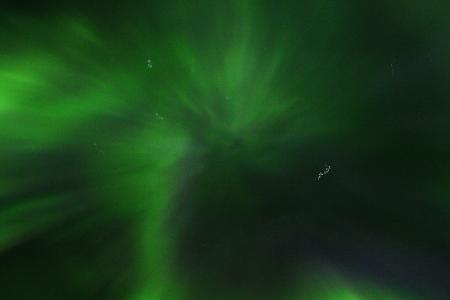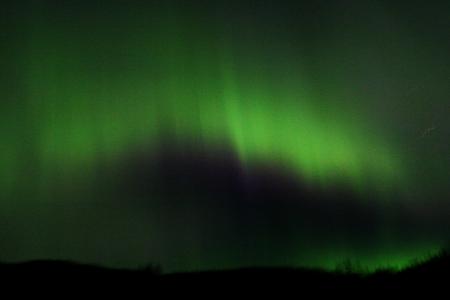Vertical View,
Aurora Borealis, July 26, 2004,
Glacier Point, Portland Canal.
Star at right center is Vega/α Lyrae
Horizontal View,
Aurora Borealis, July 26, 2004,
Glacier Point, Portland Canal.
Unlike native Alaskans I don't often see the northern lights, in fact, until this season I have only seen a diffuse glow in comparatively unfavorable circumstances. But on the night of July 26th I saw a classic auroral display, straight up — one of nature's more beautiful light shows.
Briefly, auroral displays represent the last leg of a 150 million kilometer (93 million mile) journey for solar wind particles. The sun emits charged particles which take about three days to travel to Earth, they are then guided by Earth's magnetic field to ring-shaped areas over the north and south magnetic poles. I just happened to be at a location along the edge of the northern ring, so my aurora display appeared mostly straight up.
I want to strongly emphasize that a firsthand auroral display is not remotely captured in photographs, and if you have any possible way to see this natural wonder for yourself,
by all means do it. My pictures on this page only weakly convey the actual experience because the exposure times were far too long to freeze the action of the beautiful, constantly moving green curtains of light (this is a universal problem in photographing auroral displays).
While anchored at Glacier Point on the Portland Canal in Southeast Alaska on July 26th, I happened to look outside around 11 PM ... and saw a sky full of moving green curtains of light! I went out on deck and found that I couldn't stop looking at nature's light show. I must have mutely stared at the mesmerizing display for 45 minutes while the eager, grateful mosquitoes lunched on my temporarily brain-dead corpus.
I cannot tell you how beautiful it was — a silent, glowing, twisting display of solar particles colliding with Earth's upper atmosphere, a moving pattern of green curtains, always surprising me with their next move. Somehow during the next half-hour I managed to grab my camera and, sensing the display was about to end, I tried a desperate tactic: I took several handheld, six-second exposures at an equivalent ASA speed of 1600 (true for both exposures shown here), a trick the better digital cameras let you do.
What this means in practical terms is the very distinct, sharp-edged curtains of light are blurred by the length of the exposures (and the fact that they were hand-held), and images of stars (see upper picture) end up wiggly tracks created by camera motion (the star image at right center of the top photo is Vega/α Lyrae).
The display came to an end rather abruptly — it must have been a comparatively brief burst of solar particles. Then I saw something in what I will call the afterglow of the auroral display that I think may not be very well-known. As the bright display ended, I saw periodic flashes of light covering about 20 degrees of arc, repeating at somewhat less than one-second intervals. These flashes appeared in the regions that had been filled with auroral light a few minutes before, and they possessed a component of sweeping motion.
I don't know whether this flashing aftereffect is well-known among those who study the auroral light (and I was in a location with a very dark night sky, no nearby human settlements), but I think I may have an explanation for it. After the main display ended, there were still plenty of charged particles available at the edge of earth's atmosphere, and, as those of you who have studied physics will know, neutral atoms represent a lower energy level than charged particles, and over time matter tries to get to its lowest enery level.
My theory is that a recombination of electrons and protons (in one form or another) would spontaneously begin at some location, and the light emitted by this event would serve to trigger other, adjacent charged particle pairs to recombine, thus creating a fast-moving wave of recombination events and associated light. What I found surprising was the size of the cascades — given their angular size of about 20 degrees and the known heights of auroral displays (about 100 km), — the largest cascades appear to have transited across (100 km * sin(20)) more than 30 km in less than a second.
I should add these cascades of light were a great deal dimmer than the prior auroral displays, and they would require some truly exotic equipment to study in any systematic way. And it occurs to me that they may possibly not have been studied to date. Also, it is not that common for an auroral display to come to an end in the abrupt way I saw, so this specific aftereffect, if it is in fact produced the way I think, may not have been observed before.
While I was thinking about this rather esoteric physical process, oblivious to my immediate surroundings, the mosquitoes were having a feast. I finally realized the price I was paying for a clear view of the sky in summertime Alaska, so as the last bit of glow dissipated, I took shelter in my boat's cabin.
For those of you who really want to see auroral displays and won't allow any practical considerations to stand in your way, I suggest that you visit Fairbanks in the wintertime (I hasten to add this is advice I am not ready to take). Fairbanks, located well inland from the Alaska coast, is comparatively dry and cloud-free (and very cold in winter), the winter temperatures kill off the mosquitoes, and in late December the night (of a darkness suitable for viewing the aurora) is about 16 hours long. All you have to do is stand outside in the deathly cold in the winter at a location near the Arctic Circle, and wait for the sun to coöperate.


 Share This Page
Share This Page

 Share This Page
Share This Page




 Share This Page
Share This Page